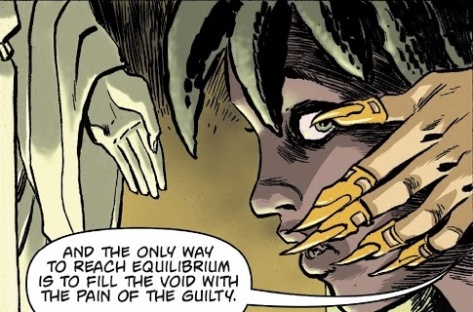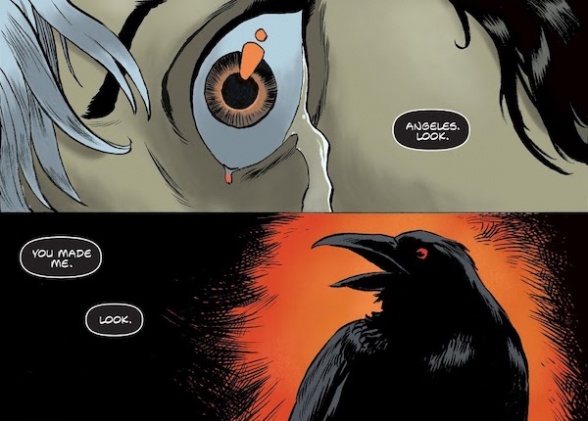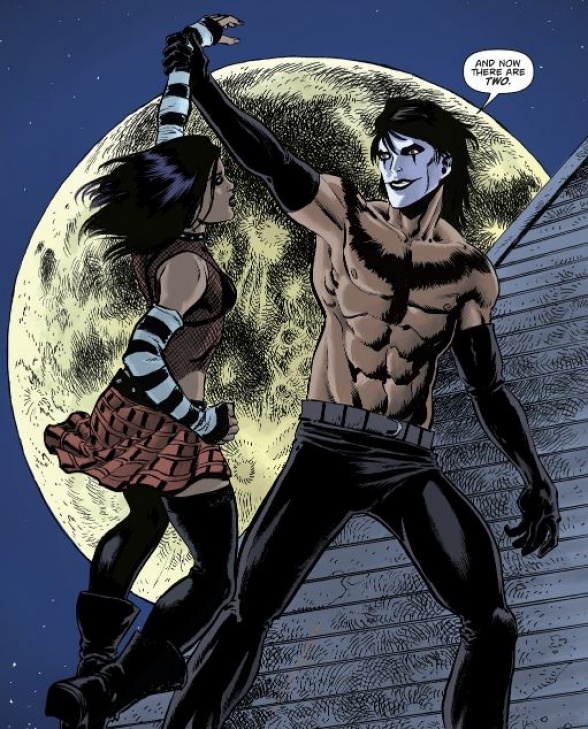Welcome to Butcher’s Block, our “Hack/Slash” annotation. Due to some scheduling of releases, we will be addressing the first issue of the crossover that began in the last week of June, but not the second, which will be released next Wednesday (July 31, 2019).
As a note: unlike some other analyses, this one will not skimp on spoilers, though it will still attempt to be new reader friendly by way of bringing up past information.
Furthermore, for sake of clarity: “Hack/Slash” is a mature comic book series. As such, many images may not be suitable for younger audiences, and quotations and/or panels may include liberal curses and mature content such as profanity, violence, or sexual imagery.
New Concepts
Victim of the Week

While the nature of “Hack/Slash vs. Chaos!” didn’t allow for much room to show this aspect outside of the very first issue’s opening victims, instead concentrating on the journey, such an element is extremely common in “Hack/Slash” stories on account of dealing primarily with undead serial killers.
For the record, having a victim for each story arc of a series does not necessarily mean the same thing as the standardized victim presented here. For villains in media to be… villainous, they often need to antagonize someone or something. Superhero comics can have victims of crime without having them killed, after all. What makes the “Hack/Slash” victim profile different is the fact that, by and large, these people do not survive their introductions. After all, having these victims is part and parcel to what the slasher bashers do anyway: track killers based on their movement around the country, view their modus operandi, and take them down. Serial killers without any bodies wouldn’t really make much sense, and Cassandra “Cassie” Hack herself has noted that she is a hunter and a killer, not a hero.
To be a victim of the week, a character fills out a selection of traits. The victim is presented early on, commonly dead by the end of the first issue of an arc, if not already dead when first introduced or, most common of all, only getting a page or two.
The presentation of these characters tend to have a collection of similarities if they are seen before their nigh inevitable deaths. We are introduced to them performing some action or another that could be construed as why they are the target of a killer, ranging from a variety of actions that could be seen as “sinful” to underage people (premarital sex, illicit drug use) to more adult-oriented activities such as blackmail or, in some cases, overall rudeness in general. In the midst of these activities or shortly after them, they are killed brutally by the arc villain, who is sometimes (but not always) seen framed in shadows with concentration on their murder weapon instead. Many times, the victims do not see the killer until a mere second or two before their death, resulting in a stock scream as they die.
Considering the slasher film focus, said victims are often teenagers engaging in “sinful” actions like drug use (from alcohol to smoking and more) or sexual intercourse. Or, to quote Hack upon returning to the business in full during “Hack/Slash vs. Chaos!” #1, “We’ve got dead half-clothed teenagers doing desperately stupid things in a remote location.” The ridiculous actions have been updated with the times, used to comment on facets of society that a writer finds distasteful, such as online video “personalities” of the mid to late 2010s. The modi operandi of slashers are so similar in regards to the type of victim that often the type of killer can be identified by these traits alone.
Of course, the definition of a victim of the week is many times looser than the teenagers described above. Other creatures, from vampires to demons and more, have their own selections of targets. At times, the typical traits are played around to make a victim of a different age appear to be from a supernatural killer, only for the assumption to be proven wrong. But it isn’t as though Cassie Hack is a professional profiler, and she can at times (read: often) do “desperately stupid” things herself in her own way.
Continued belowAs a note, the fact that many killers in the series are undead may make for some confusion over what accounts for a victim of the week. While villains may have their first death and origin story shown at the beginning of an arc, the treatment of their death is very different from the victim of the week, who starts the case itself through their inclusion.
Typically, there are three forms of the victim of the week: postmortem, brief, and extended.
Readers only encounter a postmortem victim, as the designation implies, after their death, having been presumably killed as part of the threat posed by the present arc’s villain. Catching such a person involves trespassing on crime scenes or breaking into a morgue, and is only used to investigate how such a person was killed in order to gather clues on the possible future actions of the assailant, not unlike many a detective story. One such victim is alluded to (but not directly seen beyond the crime scene itself) in “The Crow: Hack/Slash” #1, starting off the case in full through a rough examination of the other clues around.
The brief victim has only a page or two, three at best, to give characterization before the gruesome killing. While not in “The Crow: Hack/Slash,” the camera crew in the opening of “Hack/Slash vs. Chaos!” #1 definitely qualifies.

The extended victim, as exemplified by the drug addict Lucy in “The Crow: Hack/Slash” #1, has much more screen time. Sometimes, said character might even last up to an entire issue before being killed off in the next one. Such a variation goes to showcase the failings of our protagonists and provides reasons to care about the victim, whether relief or sadness at their demise (depending upon their personality).
Crow Mythology

“People once believed that when someone dies, a crow carries their soul to the land of the dead… but when the soul is burdened by terrible sadness, the Crow seeks to balance the scales by ferrying them back to the land of the living to set things right.”
First released in 1994, James O’Barr’s “The Crow” has its own mythology, one that has evolved over time as it incorporated elements from both the original graphic novel and subsequent related installments in various media, most notably in comics and films.
The primary element of the mythological aspects is the idea of a crow bringing back the dead as a revenant to secure vengeance in the name of love lost. While there are no deliberate connections to myths in various cultures, there are a variety of elements that do connect. In the Quran (specifically Chapter 5, Verse 31), crows are credited with teaching the son of Adam (identified as Cain in other religions) how to bury the brother he murdered. In Irish myths, the Morrigan is a corvid-affiliated goddess of war and death. Hinduism has crows representative of omens to give people information regarding their stations in life. Various other examples exist, including other corvids as well.
Linking crows with death is not entirely uncommon. They scavenge from the dead, and are seen often in popular culture around death, from battlefields to gallows and more. But on another note, they are also known to hold funerals for their dead and the dead that they hold in high regard.
While there is a possible mundane explanation to how the eponymous bird and its reborn agent in “The Crow” functions, namely that the “reborn” was revived on an operating table and subsisted for a year and made insensitive to pain due to brain injuries, grief, and anger, the film series, on top of subsequent installments of the comics from which “The Crow: Hack/Slash” takes reference, deals with a more mystical variation.

Crows have a variety of powers derived from their patron, as showcased in the crossover, all rooted in the concept of love lost (be it the love for the lost in and of itself, or the pain that comes from that love). They can heal from nearly everything but self-inflicted wounds. They have heightened reflexes and strength to the degree of breaking necks with little to no effort. Due to their undead state, they feel neither pain, nor fatigue. They have a degree of tactile telepathy and empathy for both living beings and inanimate objects associated with those beings, to the degree of being able to understand a person’s past by touching them, including emotions. They can transform physically into a crow, gaining the ability to fly and, at least in the case of Angeles Cero, a kind of “crow breath” to release feathers from the mouth (though said “power” appears to be a kind of sickness or detriment). Senses are greatly enhanced to allow for their hunting un-lifestyle, including even the ability to share their senses with the Crow itself to see further and in total darkness.
Continued below
Still, Crows are not entirely invincible, and there are a number of ways to either remove their powers or lessen them. Crows’ nigh immortality is reliant upon both their mission and the Crow itself. If the Crow is killed (a difficult feat due to its resilience), the reborn agents are rendered mortal, though they do not lose their other abilities. If Crows stray from their mission to bring peace to their loved ones and themselves, whether by being tricked into believing that they had completed said mission or by voluntary abandonment, they may lose their powers, with the beginnings of rigor mortis likely to set in. With how Angeles Cero seems to be sick with a bad cough, alongside her decision to murder people who do not seem to have much to do with revenge for her designated deaths and apparently caging the supernatural crow (though that latter one seems like it could be someone else due to the different diction), this abandonment seems to be setting in, and she seems to have at least some awareness of what it means for her.

On top of all of that is another element brought up by the as of yet unnamed heroic Crow, at the end of “The Crow: Hack/Slash” #1. “One at a time. That’s the way it’s supposed to go. With a crow to guide one back to the land of the living. But the crow is gone now. And now there are two.” The implication seems to be that, with the supernatural crow locked up, something has gone wrong with the cycle of reborn agents.
New Issues
The Crow: Hack/Slash #1

While having specialized powers beyond their durability and healing (like the crow-based breath power shown by Angeles Cero) is not unusual for slashers, the Serial Killer Killer unfortunately misjudged what she was dealing with when she came to this most recent case in San Francisco. For all of her (justified) claims to be a “specialist” when it comes to slashers, Cassie Hack has a bit of a history with misidentifying them regardless. Although the result is never truly lethal owing to her understanding the problem just in time, her misunderstanding as to the nature of Angeles Cero’s powers (and how they do not result in the same kind of necrology common to slashers) is still no anomaly.
At age nineteen in ‘The Coldest Dish’ (“Hack/Slash: The Series” #11), she went out of her way to hunt down someone she thought to be a slasher who was being seen well by the general populace, but due to her neglecting to do her proper research beyond “masked killer” to keep from thinking about her crush Margaret “Georgia Peaches” Crump or her as-of-then unsuccessful attempts to find her father, she ended up hunting for Nathan, someone who has more in common with vigilante Frank Castle (a.k.a. “the Punisher”) than a supernatural horror movie villain, in effect someone not too different from she herself. Another time, at roughly age 20, she misidentified the second “Catalog Killer” in ‘The Case of the Killer and the Questing King’ (“Hack/Slash” #18), but that case is more understandable in that she and her allies were deliberately misled in the hopes of killing her for the death of the first one.

By the end of the debut issue to this crossover, we seem to have the beginnings of the true team-up element to the story, with the heroic of the two Crows saving Cassie from falling to her death. As seen from as recently as her temporary alliance with the Chosen and Ernest “Evil Ernie” Fairchild back in “Hack/Slash vs. Chaos!,” Ms. Hack is no stranger to teaming up with supernatural beings. In fact, Vampirella is on good enough terms with her after their first run-in through Las Vegas (“Hack/Slash vs. Vampirella”) that she was called up again recently as a few months back in their likely time span, at most, during the ‘Return to Haverhill’ story arc (“Hack/Slash Resurrection” #8-11).
Unfortunately, when it comes to dealing with a threat that is very similar to the one seen as an ally, things tend to go quite a bit more sideways, to say the least. The tragedies of impulsiveness and emotion that ran through Cassie’s alliance with Samhain in the original run of the epic caused no end of horrific pain, both psychological and physical, along with quite a few deaths along the way that she refused to accept her fault in after a point. Having Vampirella aid her against a leader of a vampire coven resulted in her having to face off against two very powerful vampires with disparate abilities once her friend was temporarily hypnotized. It’s not a sure thing, as shown by how her work with the Necronomicon ex Mortis-afflicted Deadite slayer Ashley J. “Ash” Williams didn’t backfire on her (in fact, she was nearly the problem there), but is still a notable enough trend. While it’s unlikely that her alliance with this Crow will go as poorly, there is enough of a track record that it wouldn’t be exactly out of the question for her to be more than a little bit concerned.
Want to know more about use of victims in the epic, or more about how the series is using “The Crow” mythos? Feel free to ask away in the comments below.






